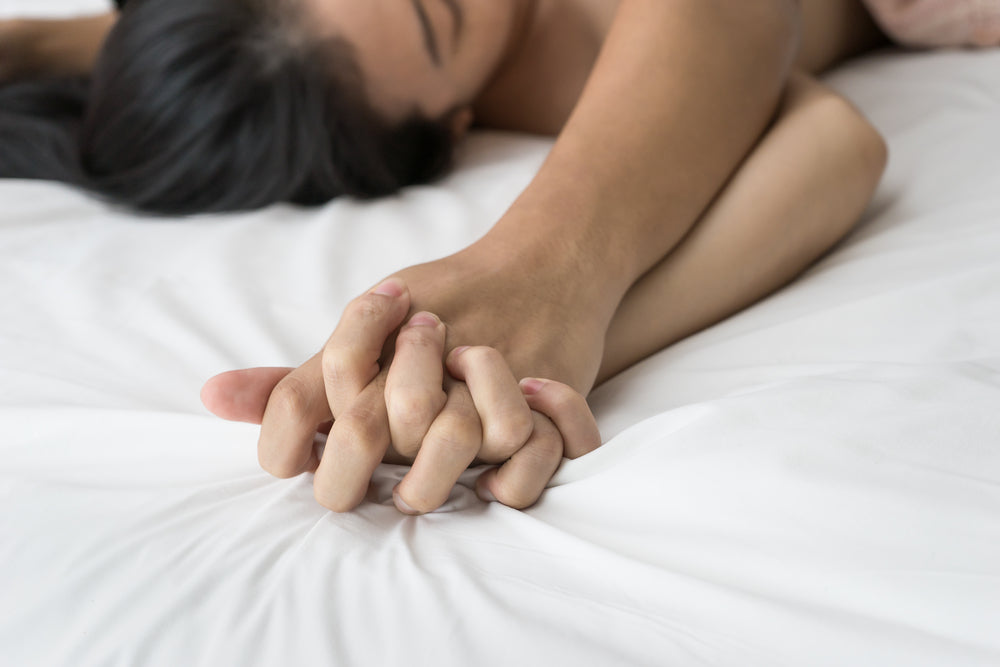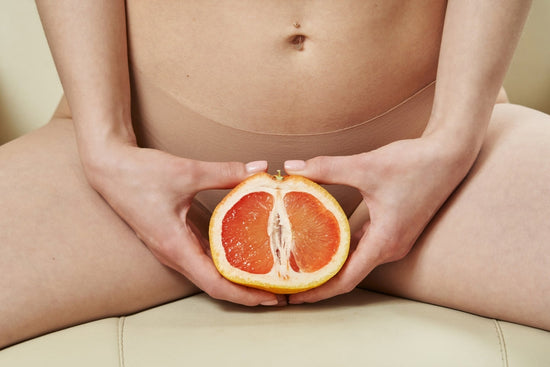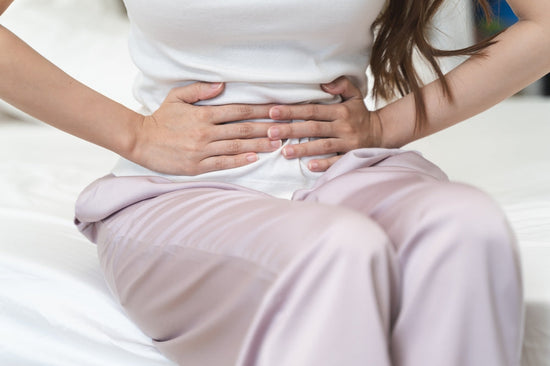An intoxicating feeling that describes the climax of a sexual activity: the orgasm ! Whether with a partner or alone - an orgasm can really get you going. We've all heard of orgasms, but maybe we don't really know what they're all about. In this blog post, we'll discuss what an orgasm actually is, what the confusing division into clitoral and vaginal orgasms is all about, and the fact that men* also have a G-spot.
*In our blog post, we use the words “man” and “male” to describe penis orgasms and “woman” and “female” to describe vaginal orgasms. Of course, there are also people with penises who do not classify themselves as men or male, and people who have a vagina but are not women/female.
What is an orgasm?
Climax, climax, orgasm - these are terms we are familiar with, but it may be difficult to explain what they really mean. That's why we want to take a closer look at them now.
Orgasm is the climax that can be triggered by various sexual activities, whether through sex or masturbation. When the climax occurs, muscle contractions occur in the genital and anal areas, but also in areas that are not part of the genital zone. In addition, blood pressure rises considerably during this process and the accumulation of blood in the vagina and penis is further increased. An increase in breathing frequency and depth is also not uncommon.
Find the right Taynie for you.Discover our diversity!
Orgasm in men and women - differences
A key difference between male and female orgasms is that men rarely get another erection and orgasm after an orgasm. Women, on the other hand, can have several orgasms in a row. But does that mean that women have more frequent orgasms than men? No, in fact, women have orgasms less often than men. To help you understand the whole thing a little better, we'll give you a percentage comparison of the frequency of female and male orgasms below.
61 percent t of all men have an orgasm every time during intercourse. The situation is different for women, who only experience 27 percent always have an orgasm when they have sex.
Four phases of orgasm
Have you ever heard that orgasm can be divided into 4 different phases that occur one after the other? We would now like to explain the four phases of orgasm to you.
Excitement phase
When arousal occurs, not only does breathing increase, but so does pulse and blood pressure. Various things can trigger arousal. For example, visual perceptions, scents or dreams. If erogenous areas are touched, the arousal increases even further. Erogenous zones are not just the penis and vagina, but can also be the breast, mouth or neck.
When a woman is in the phase of arousal, the clitoris and the labia swell. The vagina also becomes moist, wider and longer and the uterus becomes slightly raised.
In men, the whole thing looks like this: when aroused, the blood flow to the penis increases and the size of the penis increases. The scrotum and testicles, on the other hand, contract when aroused.
Plateau phase
In this phase, sexual stimulation has already begun and excitement has increased significantly. In this phase, you already notice that you are close to climaxing. And do you know what is particularly good news? On top of that, happiness hormones are also released.
orgasm
Watch out, now comes the climax! Here various muscles contract rhythmically. The tension that was still present in the previous phase is now released. Did you know that this can even lead to states that resemble fainting? An orgasm can be quite intense and bring with it a real package of power. The so-called prefrontal cortex of the brain is responsible for this, which is responsible for sensory impressions and is partially switched off in this phase. For the brain, this means that it quickly falls into a sleep-like state.
Relaxation phase
Enough excitement, now it's time to relax! We have the hormone oxytocin to thank for this. Blood pressure, pulse and breathing return to normal and the genital area becomes drier and swollen. In men, this can lead to a lack of sensitivity to stimulation, meaning that it can take a while for the penis to become erect again. It's different for women, who can even experience further, so-called multiple orgasms. Noradrenaline and adrenaline are probably responsible for this, both of which experience a rise after climax.
But be careful: not all women are in the mood at this point, as the vagina may become hypersensitive afterwards, so excessive stimulation should be avoided.
What happens during the female orgasm?
Do you want to know what exactly happens during a female orgasm? Then pay attention, we're going to tell you now! ;)
Sexual stimulation begins and a lot of tension can build up. However, when the orgasm occurs, this accumulated tension is released again in a short time. This causes the vaginal, pelvic floor and uterine muscles to contract.As you can see, the female orgasm requires all of her muscle power. Before a woman has an orgasm, the sex hormone estrogen distributed.
Did you know that a woman for 30 seconds can experience the tingling, intense feeling of an orgasm? And another exciting fact: women experience orgasm more often when they have same-sex sex than when they have heterosexual sex.
Vaginal and clitoral orgasm
Let us now talk about the great mystery of the clitoral and vaginal orgasm. Although it is now assumed that both orgasms are a clitoral orgasm However, people still talk about clitoral and vaginal orgasms. This wording is probably easier to distinguish between the stimulation of the clitoris and the stimulation of the inside of the vagina.
Clitoral orgasm
But how does a "clitoral" orgasm actually work? The clitoral pearl, which is located at the top of the labia, can be stimulated by various things: fingers, tongue or sex toys can be used. Preferences are very individual, as is the amount of pressure preferred during stimulation. From light pressure to tapping or gentle stroking, anything can be used, and that is why we can give you an important tip at this point: communication is key, even during sex! Because only through open communication can you find out what your partner likes.
Vaginal orgasm
Now let's talk about the "vaginal" orgasm. The stimulation takes place inside the vagina, either through fingers, sex toys or penis. Many nerve endings there ensure sexual pleasure. A particularly beneficial area for internal stimulation of the vagina is the G-spot. This is a tissue that is particularly sensitive and can swell due to sexual arousal. Did you know that this tissue has glands through which a fluid can be secreted? This is even often referred to as "female ejaculation". But where is the G-spot actually? It is about 3-5 cm away from the entrance to the vagina. This area can be felt with a finger because it feels rougher than the rest of the area in the vagina.
What happens during the male orgasm?
Are you curious and would like to find out what the male orgasm is all about? Then you can read on with interest. The first step before the male orgasm occurs is the erection , i.e. the stiffening of the penis. The second step is then the ejaculation , i.e. ejaculation, which can be achieved not only through physical but also through mental stimulation. Before this is achieved, however, the hormone testosterone is released.
When the penis is stimulated during penetration, the prostate and seminal vesicle contract. When it is time for orgasm, an incredible 200 million sperm can be released from the penis. A man's climax lasts less time than a woman's. Men usually ejaculate and have the pleasant feeling of an orgasm for 3 to 12 seconds.Once the orgasm is over, you often feel tired, which is due to the hormone prolactin.
Do you have a so-called “dry” orgasm without ejaculation? Then you should make an appointment with your urologist and have it checked out.
G-spot in men
Is there a G-spot in men? Yes, there is indeed! The female G-spot probably receives more communicative attention than the male G-spot. That is why we want to tell you about the male G-spot. The male G-spot is the prostate . It is therefore often referred to as P-point You can imagine the prostate being the same size as a walnut.
But where exactly is the prostate? The prostate is located beneath the bladder and enclosing the urethra. The prostate is particularly easy to find in the anus, about 5 to 7 cm behind it, towards the front intestinal wall. The prostate can be stimulated directly via the anal route, but a gentle massage of the perineum, i.e. the region between the anus and the scrotum, can also lead to indirect stimulation.
However, the following must be taken into account when performing anal stimulation: hygiene and lubricant (water-based if you are using latex condoms). Hygiene plays a crucial role here, because anal stimulation can bring fingers, penises or sex toys into contact with feces. Penises and sex toys should therefore be covered with a condom. Speaking of condoms: Safer sex is also a top priority here, because anal sex also carries a risk of contracting a sexually transmitted disease. Therefore, condoms should never be used without one.





